人教版英语必修一Unit 2 English around the world教学设计全面版
文档属性
| 名称 | 人教版英语必修一Unit 2 English around the world教学设计全面版 |
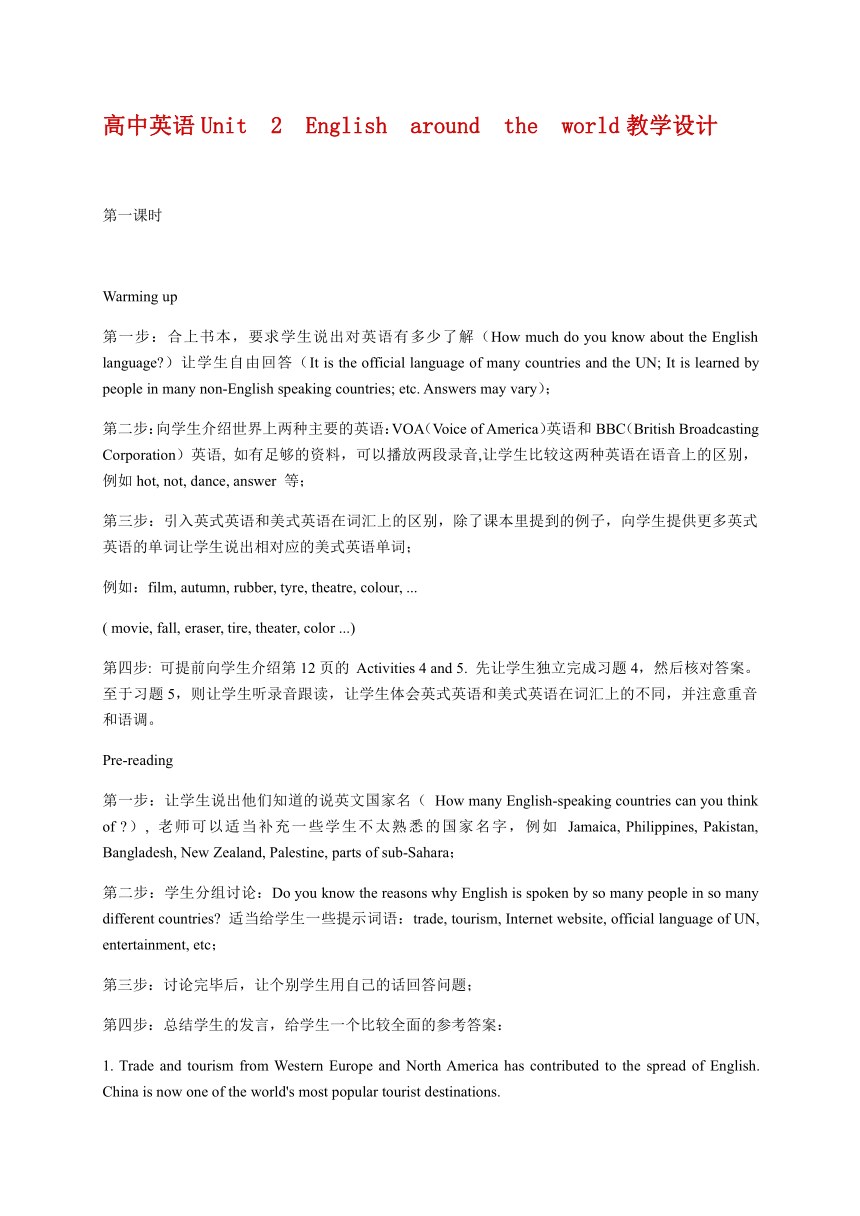
|
|
| 格式 | zip | ||
| 文件大小 | 50.5KB | ||
| 资源类型 | 教案 | ||
| 版本资源 | 人教版(新课程标准) | ||
| 科目 | 英语 | ||
| 更新时间 | 2019-12-16 20:01:47 | ||
图片预览

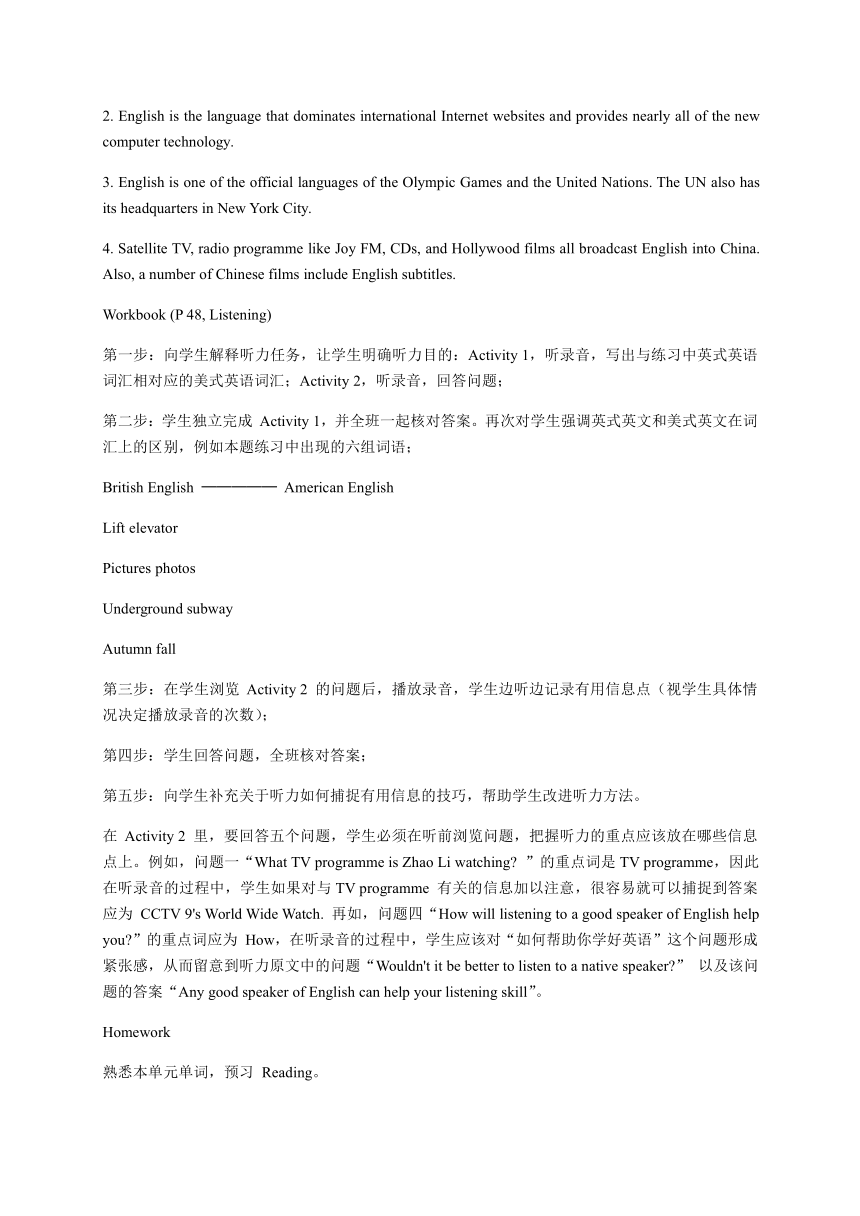
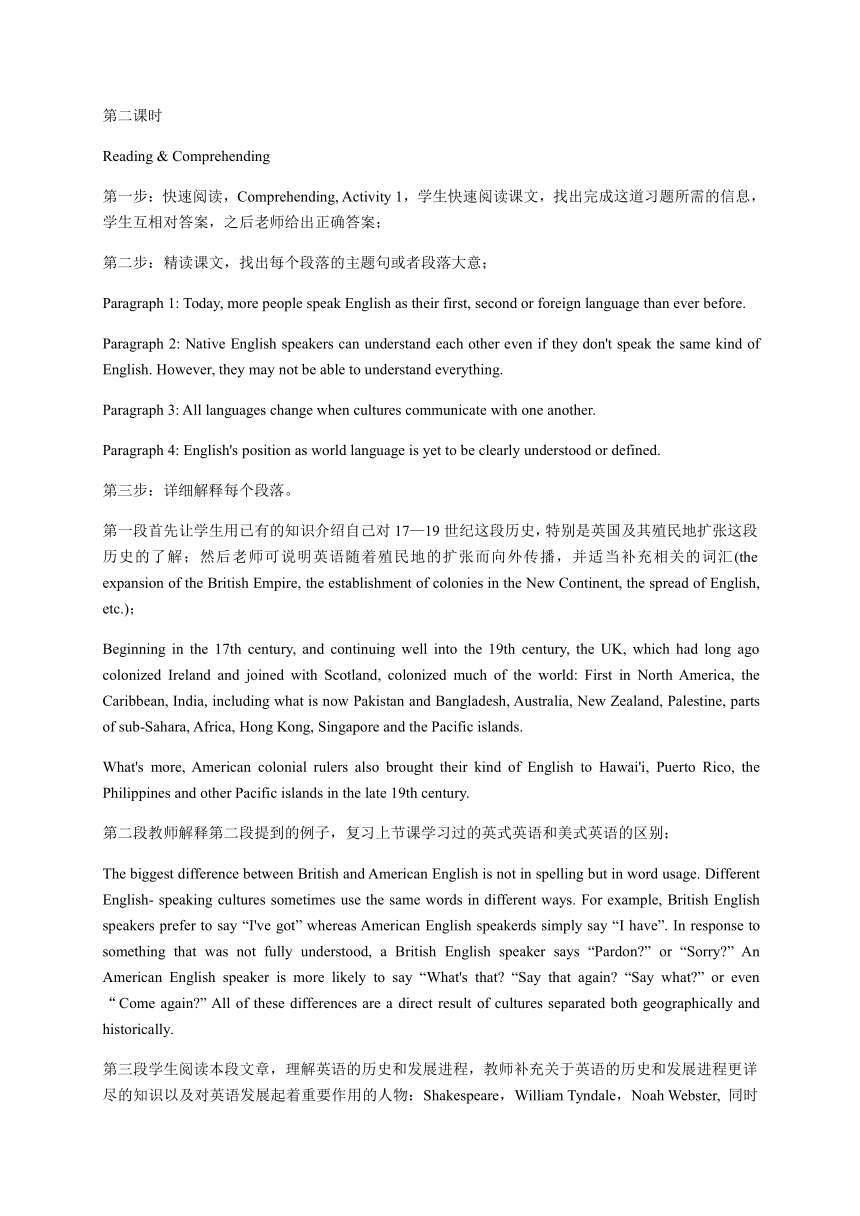
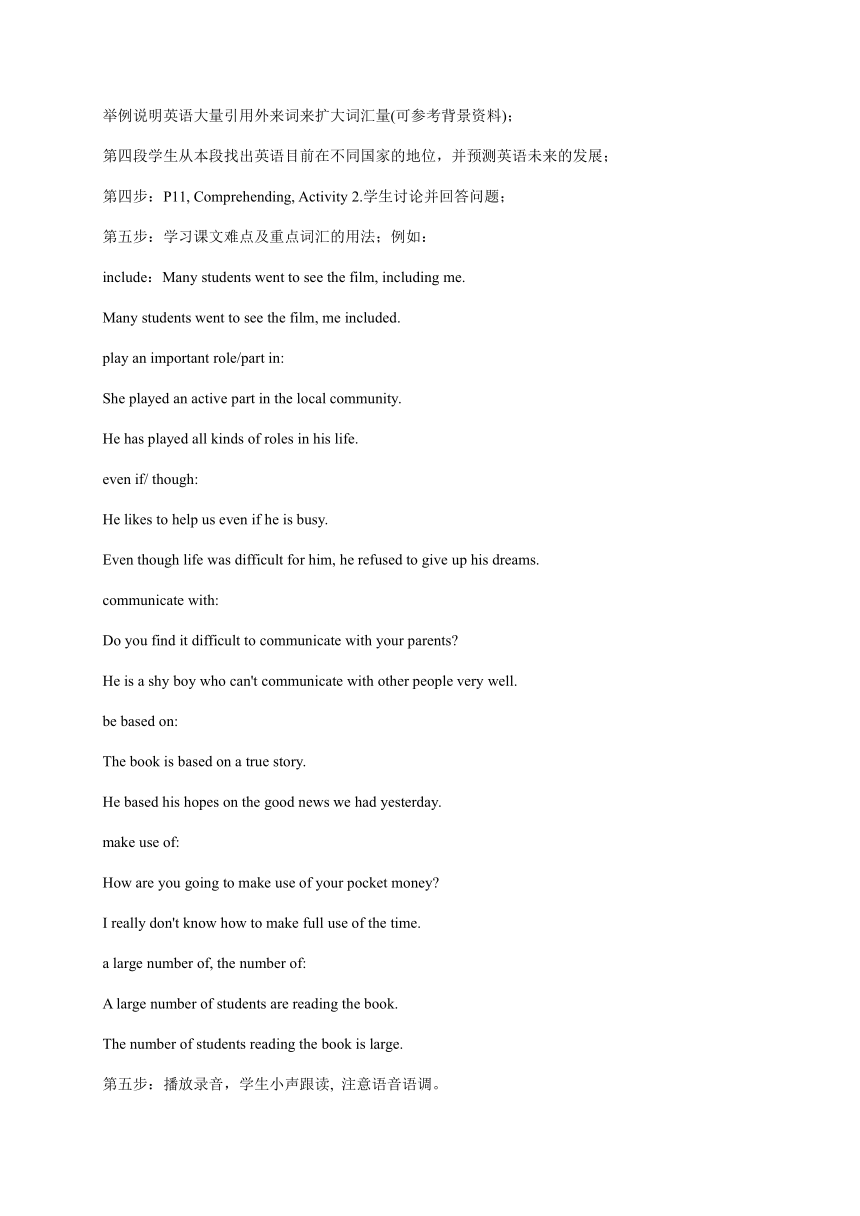
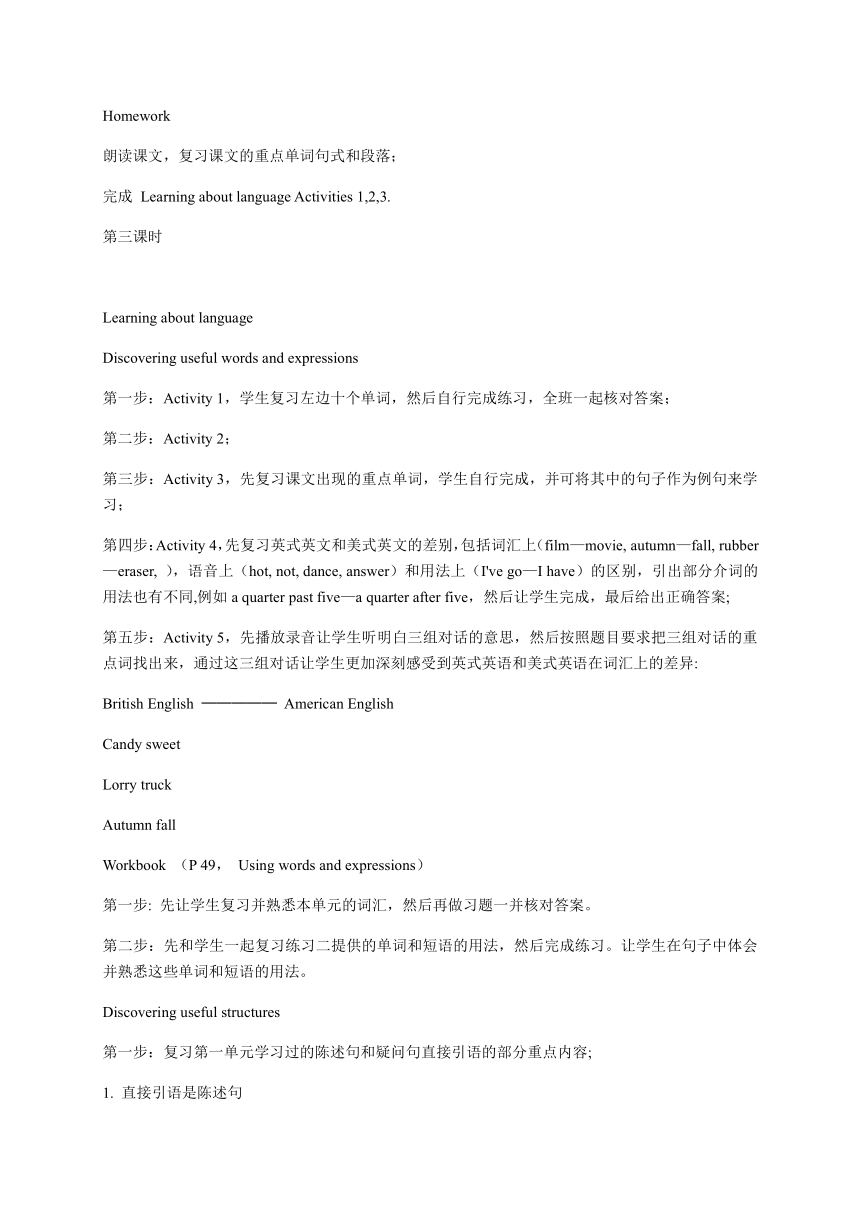
文档简介
高中英语Unit?2?English?around?the?world教学设计
第一课时
Warming up
第一步:合上书本,要求学生说出对英语有多少了解(How much do you know about the English language?)让学生自由回答(It is the official language of many countries and the UN; It is learned by people in many non-English speaking countries; etc. Answers may vary);
第二步:向学生介绍世界上两种主要的英语:VOA(Voice of America)英语和BBC(British Broadcasting Corporation)英语, 如有足够的资料,可以播放两段录音,让学生比较这两种英语在语音上的区别,例如hot, not, dance, answer 等;
第三步:引入英式英语和美式英语在词汇上的区别,除了课本里提到的例子,向学生提供更多英式英语的单词让学生说出相对应的美式英语单词;
例如:film, autumn, rubber, tyre, theatre, colour, ...
( movie, fall, eraser, tire, theater, color ...)
第四步: 可提前向学生介绍第12页的 Activities 4 and 5. 先让学生独立完成习题4,然后核对答案。至于习题5,则让学生听录音跟读,让学生体会英式英语和美式英语在词汇上的不同,并注意重音和语调。
Pre-reading
第一步:让学生说出他们知道的说英文国家名( How many English-speaking countries can you think of ?), 老师可以适当补充一些学生不太熟悉的国家名字,例如 Jamaica, Philippines, Pakistan, Bangladesh, New Zealand, Palestine, parts of sub-Sahara;
第二步:学生分组讨论:Do you know the reasons why English is spoken by so many people in so many different countries? 适当给学生一些提示词语:trade, tourism, Internet website, official language of UN, entertainment, etc;
第三步:讨论完毕后,让个别学生用自己的话回答问题;
第四步:总结学生的发言,给学生一个比较全面的参考答案:
1. Trade and tourism from Western Europe and North America has contributed to the spread of English. China is now one of the world's most popular tourist destinations.
2. English is the language that dominates international Internet websites and provides nearly all of the new computer technology.
3. English is one of the official languages of the Olympic Games and the United Nations. The UN also has its headquarters in New York City.
4. Satellite TV, radio programme like Joy FM, CDs, and Hollywood films all broadcast English into China. Also, a number of Chinese films include English subtitles.
Workbook (P 48, Listening)
第一步:向学生解释听力任务,让学生明确听力目的:Activity 1,听录音,写出与练习中英式英语词汇相对应的美式英语词汇;Activity 2,听录音,回答问题;
第二步:学生独立完成 Activity 1,并全班一起核对答案。再次对学生强调英式英文和美式英文在词汇上的区别,例如本题练习中出现的六组词语;
British English ───── American English
Lift elevator
Pictures photos
Underground subway
Autumn fall
第三步:在学生浏览 Activity 2 的问题后,播放录音,学生边听边记录有用信息点(视学生具体情况决定播放录音的次数);
第四步:学生回答问题,全班核对答案;
第五步:向学生补充关于听力如何捕捉有用信息的技巧,帮助学生改进听力方法。
在 Activity 2 里,要回答五个问题,学生必须在听前浏览问题,把握听力的重点应该放在哪些信息点上。例如,问题一“What TV programme is Zhao Li watching? ”的重点词是TV programme,因此在听录音的过程中,学生如果对与TV programme 有关的信息加以注意,很容易就可以捕捉到答案应为 CCTV 9's World Wide Watch. 再如,问题四“How will listening to a good speaker of English help you?”的重点词应为 How,在听录音的过程中,学生应该对“如何帮助你学好英语”这个问题形成紧张感,从而留意到听力原文中的问题“Wouldn't it be better to listen to a native speaker?” 以及该问题的答案“Any good speaker of English can help your listening skill”。
Homework
熟悉本单元单词,预习 Reading。
第二课时
Reading & Comprehending
第一步:快速阅读,Comprehending, Activity 1,学生快速阅读课文,找出完成这道习题所需的信息,学生互相对答案,之后老师给出正确答案;
第二步:精读课文,找出每个段落的主题句或者段落大意;
Paragraph 1: Today, more people speak English as their first, second or foreign language than ever before.
Paragraph 2: Native English speakers can understand each other even if they don't speak the same kind of English. However, they may not be able to understand everything.
Paragraph 3: All languages change when cultures communicate with one another.
Paragraph 4: English's position as world language is yet to be clearly understood or defined.
第三步:详细解释每个段落。
第一段首先让学生用已有的知识介绍自己对17—19世纪这段历史,特别是英国及其殖民地扩张这段历史的了解;然后老师可说明英语随着殖民地的扩张而向外传播,并适当补充相关的词汇(the expansion of the British Empire, the establishment of colonies in the New Continent, the spread of English, etc.);
Beginning in the 17th century, and continuing well into the 19th century, the UK, which had long ago colonized Ireland and joined with Scotland, colonized much of the world: First in North America, the Caribbean, India, including what is now Pakistan and Bangladesh, Australia, New Zealand, Palestine, parts of sub-Sahara, Africa, Hong Kong, Singapore and the Pacific islands.
What's more, American colonial rulers also brought their kind of English to Hawai'i, Puerto Rico, the Philippines and other Pacific islands in the late 19th century.
第二段教师解释第二段提到的例子,复习上节课学习过的英式英语和美式英语的区别;
The biggest difference between British and American English is not in spelling but in word usage. Different English- speaking cultures sometimes use the same words in different ways. For example, British English speakers prefer to say “I've got” whereas American English speakerds simply say “I have”. In response to something that was not fully understood, a British English speaker says “Pardon?” or “Sorry?” An American English speaker is more likely to say “What's that? “Say that again? “Say what?” or even “Come again?” All of these differences are a direct result of cultures separated both geographically and historically.
第三段学生阅读本段文章,理解英语的历史和发展进程,教师补充关于英语的历史和发展进程更详尽的知识以及对英语发展起着重要作用的人物:Shakespeare,William Tyndale,Noah Webster, 同时举例说明英语大量引用外来词来扩大词汇量(可参考背景资料);
第四段学生从本段找出英语目前在不同国家的地位,并预测英语未来的发展;
第四步:P11, Comprehending, Activity 2.学生讨论并回答问题;
第五步:学习课文难点及重点词汇的用法;例如:
include:Many students went to see the film, including me.
Many students went to see the film, me included.
play an important role/part in:
She played an active part in the local community.
He has played all kinds of roles in his life.
even if/ though:
He likes to help us even if he is busy.
Even though life was difficult for him, he refused to give up his dreams.
communicate with:
Do you find it difficult to communicate with your parents?
He is a shy boy who can't communicate with other people very well.
be based on:
The book is based on a true story.
He based his hopes on the good news we had yesterday.
make use of:
How are you going to make use of your pocket money?
I really don't know how to make full use of the time.
a large number of, the number of:
A large number of students are reading the book.
The number of students reading the book is large.
第五步:播放录音,学生小声跟读, 注意语音语调。
Homework
朗读课文,复习课文的重点单词句式和段落;
完成 Learning about language Activities 1,2,3.
第三课时
Learning about language
Discovering useful words and expressions
第一步:Activity 1,学生复习左边十个单词,然后自行完成练习,全班一起核对答案;
第二步:Activity 2;
第三步:Activity 3,先复习课文出现的重点单词,学生自行完成,并可将其中的句子作为例句来学习;
第四步:Activity 4,先复习英式英文和美式英文的差别,包括词汇上(film—movie, autumn—fall, rubber—eraser, ),语音上(hot, not, dance, answer)和用法上(I've go—I have)的区别,引出部分介词的用法也有不同,例如a quarter past five—a quarter after five,然后让学生完成,最后给出正确答案;
第五步:Activity 5,先播放录音让学生听明白三组对话的意思,然后按照题目要求把三组对话的重点词找出来,通过这三组对话让学生更加深刻感受到英式英语和美式英语在词汇上的差异:
British English ───── American English
Candy sweet
Lorry truck
Autumn fall
Workbook (P 49, Using words and expressions)
第一步: 先让学生复习并熟悉本单元的词汇,然后再做习题一并核对答案。
第二步:先和学生一起复习练习二提供的单词和短语的用法,然后完成练习。让学生在句子中体会并熟悉这些单词和短语的用法。
Discovering useful structures
第一步:复习第一单元学习过的陈述句和疑问句直接引语的部分重点内容;
1. 直接引语是陈述句
如果引用的句子原来是一个陈述句,变为间接引语时,在引语的开头用连词 that 来引导 ( 在口语中 that 常省去 ) ,要注意从句中人称、时态、代词、状语等相应变化。如:
“You are really my best friend,”Tom said to me.
→ Tom said that I was really his best friend.
“I will come here again tomorrow,”he said.
→ He said he would go there again the nest day.
He said : “the best seed - heads should be hung up to dry.”
→ He said that the best seed-heads should be hung up to dry.
2. 直接引语是疑问句
①如果引用的句子原来是一个一般疑问句,变成间接引语时,须用从属连词 if 或 whether 来引导 ( 不再用 that 作连词 ) 。
②直接引语如果是特殊疑问句,变成间接引语时,原疑问句中的疑问词 who, whose, what, which, where, why, how 等就成了引导间接引语的连词。
③原直接引语中的疑问语在间接引语中变为陈述语序。
④直接引语中的问号变成了句号。
⑤人称、时态、状语等也相应变化。如:
He asked,“Is it raining now? ”
→ He asked whether / if it was raining then.
The man asked me,“How old are you?”
→ The man asked me how old I was.
They asked him,“When do you harvest the wheat?”
→ They asked him when he harvested the wheat.
I asked the man,“Who are you?”
→ I asked the man who he was.
The teacher asked her,“Why did you come?”
→ The teacher wondered why she had come.
第二步:解释 command 和 request 两种句式及这两个词语的用法( give commands, make a request/ request that somebody should do),并让学生分辨这两种句子;
第三步:Activity 1,学生阅读句子,学习如何将表示命令和请求的句子变成间接引语。然后让学生说出更多表示命令和请求的句子,并将它们变成间接引语;
第四步:Activity 2, 学生比较表示命令和请求的句子在表达上有什么特点(commands are less polite while requests are polite),然后让学生说出什么人经常下命令(例如上级,长辈, 老师等),什么人经常发出请求(下级,晚辈,学生等);最后是两人活动,一个学生给命令或发出请求,另一学生将它们变成间接引语;
第五步:补充语法知识:如何将祈使句变为间接引语;
转述祈使句的时候, 要将祈使句的动词原形变为动词不定式并在动词不定式前根据句子的意思用 tell ( 命令 ) ,ask ( 请求 ) , order ( 命令 ) 等及物动词加宾语。如果祈使句为否定式,则在不定式前面加 not 。例如:
He said to the girl,“Do it at once.”
→ He ordered the girl to do it at once.
“Be quiet!”I told the children.
→ I told the children to be quiet.
He said to farmers,“Do things at the right time of the year.”
→ He told farmers to do things at the right time of the year.
“Don't grow plants in the same place year after year.”the farmer said.
→The farmer told me not to grow plants in the same place year after year.
He said,“Don't talk!”
→ He told us not to talk.
注意:有些句子虽以疑问形式出现,但并非提出询问,而是表示请求、建议、劝告等意思。这种问句通常也采取 ask , advise + 宾语 + 不定式结构来转为间接引语。如:
“Could you lend me a bike?”he said.
→ He asked me to lend him my bike.
“Would you mind waiting a moment?”
→ He asked me to wait a moment.
“Why don't you go there by plane?”
→ He advised me to go there by plane.
What about having a walk?
→ He suggested having a walk.
第六步:Activity 3,先让学生阅读三个给出的情景,然后进行两人活动,根据所给情景编写小对话,最后在课堂上表演对话。
Workbook (P 50,Using structures)
第一步:分组活动:按照练习要求分成三个同学一组进行此项活动;
第二步:适当抽几组同学将他们的活动结果演示出来,不当的地方进行及时的纠正;
第三步:让学生独自完成练习二,核对答案;
第四步:复习总结本单元的语法项目,并强调相关注意事项.
Workbook (P 48,Talking)
第一步:和学生复习方框里面的习惯表达;
第二步:和学生一起阅读所给的情景,让学生自由选择情景进行对话练习;
第三步:学生编写对话;
第四步:学生表演对话。
Homework
1. 复习本课所学的词汇和语法;
2. 预习 Using language Reading:Standard English and dialects。
第四课时
Using language
Reading and talking:STANDARD ENGLISH AND DIALECTS
第一步:教师从英式英语和美式英语的区别引出本课的话题;
第二步:学生阅读文章,总结文章的大意;
第三步:细节学习;
Why does the US have so many dialects?
1. Because people have come from all over the world.
2. Geography also plays a part in making dialects.
第四步:学习文中的知识难点:
1. Believe it or not, there is no such a thing as standard English.
Believe it or not, dinosaurs died of hunger.
2. Geography also plays a part in making dialects.
Women play an important part in today's political life.
3. Although many Americans move a lot, they still recognize each other's dialects.
We can easily recognize Mark in the crowd because he is very tall and strong.
We all recognize him as the best football player in our school.
第五步:Activity 1,不同学生用家乡方言说出同一句话,体会不同地区的方言;
第六步:Activity 2,学生说出他们知道或者听过的方言;
第七步: Activity 3,学生讨论以下问题:
Why does the government encourage us to speak Putonghua?
第八步:个别学生发表意见(课后可让学生根据本活动要求说出或者编写一个有关方言的有趣小故事)。
Workbook (P51,Reading task:The Oxford English Dictionary)
第一步:向学生简单介绍有关 The Oxford English Dictionary 的历史。
How it began
1857: The Philological Society of London calls for a new English Dictionary
More work than they thought
1884: Five years into a proposed ten-year project, the editors reach ant
One step at a time
1884-1928: The Dictionary is published in fascicles
Keeping it current
1933-1986: Supplements to the OED
Making it modern
1980s: The Supplements are integrated with the OED to produce its Second Edition
Into the electronic age
1992: The first CD-ROM version of the OED is published
The future has begun
The present: The OED is now being fully revised, with new material published in parts online
第二步:让学生快速阅读文章,找出练习所需要的信息;
第三步:全班核对答案,老师解释学生有疑问的句子;
1) The spelling f English has always been a problem but it was more of a problem in the days before a dictionary.
2) These men spent nearly all of their lives trying to collect words for their dictionaries. For them, it wasn't only a job; it was a wonderful journey.
3) It included more than 15,000 words in twelve books. And you thought your English dictionary was big!
第四步:分组快速讨论我们应该从James Murray 身上学习他的什么品质( hard working, intelligent, determined, etc);
第五步:播放录音让学生跟读,提醒学生注意语音语调和新单词的读音。
Homework
Translation:Workbook P 50, Exercise 3.
第五课时
Listening
第一步:复习 Reading 学习过的 All languages change when cultures communicate with one another. 指出语言是会发展变化的。
第二步:教师向学生介绍有关美国的地理位置、特点及其对语言的影响, 特别是美国南方的口音是很明显的。提醒学生在后面的听力中认真体会美国南部的口音。
第三步:学生看图,猜测故事的内容;
第四步:学生阅读六个要求回答的问题,猜测本篇文章的内容;
第五步:学生听录音,在文中找出所需信息;
第六步:老师和学生一起核对答案。
第七步:学生重听录音,找出带有浓重南方口音表达,感受不同口音的英语。
Speaking
第一步:学生阅读小对话,找出其中人物所用的不同词汇,老师在黑板上板书;
Amy (American) ───── Lady ( British )
Subway ───── underground
left ───── left-hand side
keep going straight ── go straight on
two blocks ───── two streets
right ───── right-hand side
第二步:两人活动,仿照上述对话使用不同的词汇编写关于问路和指路的小对话,注意要同时使用直接引语和间接引语。
第三步:老师提供地图,学生编写对话,请几组学生表演对话。
Workbook (P51,Listening Task)
第一步:Activity 1,让学生先看地图 English Around the World, 一起说出世界上讲英语的国家有哪些,让学生了解说英语的国家的分布情况。
第二步:Activity 2,假设我们是国际学校的一个班,学生都来自不同的说英语的国家,让学生用英语作自我介绍,可能的话,可以简单介绍不同国家的习俗风情。
第三步:Activity 3,听录音,两人一组合作,共同完成此项听力任务,找出听力原文中六个学生分别来自于那个国家。
Homework
复习本单元的话题内容:The English language and its development
第六课时
Writing
第一步:Exercise 1,学生学习写作前 Brainstorming 所用的步骤;
第二步:Exercise 2,教师用更具体的例子“Why should I learn English?”让学生体会如何 Brainstorming;
第三步:让学生用 Exercise 1 和 Exercise 2 所学的步骤完成 Exercise 3;
第四步:用 Exercise 3 得出的结果完成 Exercise 4;
第五步:要求学生用所学的方法于课后完成 Exercise 5 所给出的写作任务。
Workbook (P 52,Speaking Task)
第一步:先让学生阅读整段文字了解当今英语的流传方式和变化趋势。
第二步:小组讨论如何帮助英语初学者更好地学习英语。
Workbook (P 53,Writing task)
第一步:让学生先在课堂上谈论他们在学习英语方面所遇到的困难和解决的方法。
第二步:让学生展望一下他们将来将如何把学到的英语知识去开创他们的未来;
第三步:让学生按照写作要求构思每个段落,将简要的写作思路和文章的框架写下来
第四步:请一些学生说出他们是如何写这篇文章的,教师在课堂上进行讲评。
Homework
完成作文 P 16 How can learning English help China in the future?
第七课时
讲评翻译作业
第一步:事先批改翻译作业,记录学生出错教普遍的地方;
第二步:课堂上特别指出学生作业的错误让学生注意;
例如第一句“因为有病” 应用 “because of his illness” 而不是 “because of he was ill”.
第三步:提醒学生翻译过程中要注意的事项,例如不要逐字逐句翻译,要注意英文句式和中文句式的转化等,例如第2句,他们已经请求国际援助。“请求”在此句中文是作动词用,但是在翻译的过程中我们可以将它转化为名词使用,所以可以翻译为 make a request。
Learning tip
第一步:和学生一起学习本单元介绍的学习“秘诀”;
第二步:向学生提供更多例子:
1. I met my friend Jack in the plane, and I said to him, “Hi, jack” With these words, I saw all the people in the plane look at me surprisingly. Later, my friend told me not to say “hi, Jack” in the plane.
2. Why do we say that Sat. and Sun are the strongest days in a week?
3. What animal takes part in a baseball game?
4. What day do chickens hate most?
5. In which country will you be frozen to death?
6. What part of a clock is always old?
7. The farmers who grow corn say, “ We eat what we can. What we can't, we _____.” Fill in a word in the blank.
KEY: 1. hijack( 劫机) 与 Hi Jack 同音
2. Because the others are weekdays.( weak days)
3. bat 多义词:蝙蝠,球拍
4. Friday 与 fried day ( fried chicken)同音
5. Chile 与 chilly (very cold)
6. the second hand 多义词: 秒针,旧的
7. can 作动词,表示用罐子装,制成罐头。
Workbook (P53,Project)
第一步:先让学生阅读关于密码的文字,并回答问题。
第二步:让学生留意日常生活中经常使用来节省时间的“密码”,例如英语的缩略形式(somebody—sb, something—sth, hour—hr, message—mes...),数学中代数或者几何的一些表示法( 三角形ABC—△ABC, 正方形ABCD—□ABCD )。可以让学生自行创造一些他们容易接受的“密码”,在课堂上做笔记时使用,可以更快速地记录笔记,提高课堂效率。
Summing up: 复习整个单元学过的重点词汇,句型,语法。
第一步:两人一组,让学生自己总结本单元所学过的重点词汇,句型和语法,填写在书本的表格上。
第二步:让个别学生把他们总结出来的重点词汇,句型和语法向同学们展示出来,其他同学可以进行补充。
第三步:在同学们作出补充的基础上再一次和学生一起将本课话题,重点词汇,句型和语法简略复习一遍。
话题:The development of the English language.
重点词汇(及其用法):include, play a role in, because of, even though, recognize.
句型: All languages change when cultures communicate with one another.
Believe it or not, there is no such a thing as standard English.
Geography also plays a part in making dialects.
语法:祈使句的间接引语 (参考课本 P89)
Homework
1. 复习整个单元所学过的知识。
2. 预习第三单元的新单词。
【教学反思】
很多学生对英语的现状已有一定的了解,但是对其起源和发展变化了解得不多,因此在讲授这一部分内容的时候,除了在课堂上给时间让学生进行讨论,课后查找相关的资料外,可更多地把重点放在输入性的听、读方面,向学生补充了大量的有关英语发展的背景知识,让学生更加地全面而深刻地了解和体会语言,特别是英语这种语言的发展及其在不同的地区所产生的差异,让学生感受英语语言的多文化,多层次和多元性。
在教学过程中, Reading 这一部分的教学效果比较满意。这一部分介绍的是英语的传播和发展情况,很多学生对第三段,也即英语的发展情况很感兴趣,当教师引出 Shakespeare 和 William Tyndale 的时候,他们都非常专注地听,并善于把老师补充的背景知识和课文的内容很好地结合起来,达到了很好的效果。
不是很满意的部分是 P15 的 Speaking,这一部分貌似简单,但真正叫学生编写小对话的时候却不是十分顺利。因此在教学过程中最好先让学生熟记对话出现的不同词汇,适当复习一下本单元的语法项目,再让学生编写对话,效果会更好。
